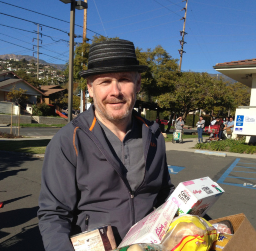Talkin’ With Talkin
Marissa Perez
Staff Writer
Q: How did you become the CEO of the Santa Barbara Foodbank?
A: My background is as a writer and a filmmaker. I was brought up in England and when I came to the States, I got involved with nonprofits. At the time, the nonprofit center wasn’t as developed in England and I was just kind of intrigued by the nonprofit center here so I started working immediately. Before I was involved in the foodbank, I was working at Casa Esperanza, the local homeless center, for several years, I’ve been doing this kind of work for a while.
Q: How can UCSB students get involved with work at the Santa Barbara Foodbank?
A: I think the best thing people can do is get engaged on the community level on helping people maintain good health through good nutrition. More than anything, we’re looking for people to get involved in our programs where we’re trying to get people involved to teach people about food nutrition and food security. Getting engaged is the key thing—everyone wants to be healthy, everyone wants to be nutritious, but not everyone knows how. We work with 300 agencies around the county to work on these programs that students can be involved in and also work on challenges facing students through programs like the UCSB foodbank.
Q: So, you’re living on food stamps for a month as part of what you’re calling the Food Security Challenge. What are you planning to do for your challenge?
A: Each week of the month I will be looking at a different aspect of living on food stamps—from getting advice from the Foodbank’s dietician on eating smart, finding out what nonprofit services are available to me as a resident on SB’s Eastside, how I can grow some of my own food. I’ll be traveling to freezing cold Chicago to both see how the situation in SB differs from that in a big city and also meeting with Feeding America to look at the national situation with food stamps. I’ll be finishing off my challenge with a few days of living in my car, without access to a kitchen and depending on local soup kitchens. The Food Security Challenge is not a gimmick; it’s a chance for me to keep in direct touch with how the Foodbank is trying to move people from hunger to health.
Q: What’s been the most difficult part of the Food Security Challenge?
A: I think the most challenging part is bringing the energy and attention required with what I’m buying, how I’m preparing it, how I’m storing it, that kind of thing. If you’ve got a lot of money, you’re not thinking about it nearly as much. You can let food go bad and throw it out to buy something new, you can go out and grab fast food for dinner, that kind of thing. If you’re on food stamps long term, it just requires a different lifestyle. The real challenge is giving the time and focus to what I’m eating to make sure I’m eating healthy.
Q: Are there any of your other efforts that students can check out?
A: I really recommend they look at my blog, From Hunger to Health, that explores some of the deeper issues of hunger that are behind the challenge.
Talkin’s blog, From Hunger to Health, is located at http://hungerintohealth.com/ and you can keep up with his Food Security Challenge at http://foodsecuritychallenge.wordpress.com/.











